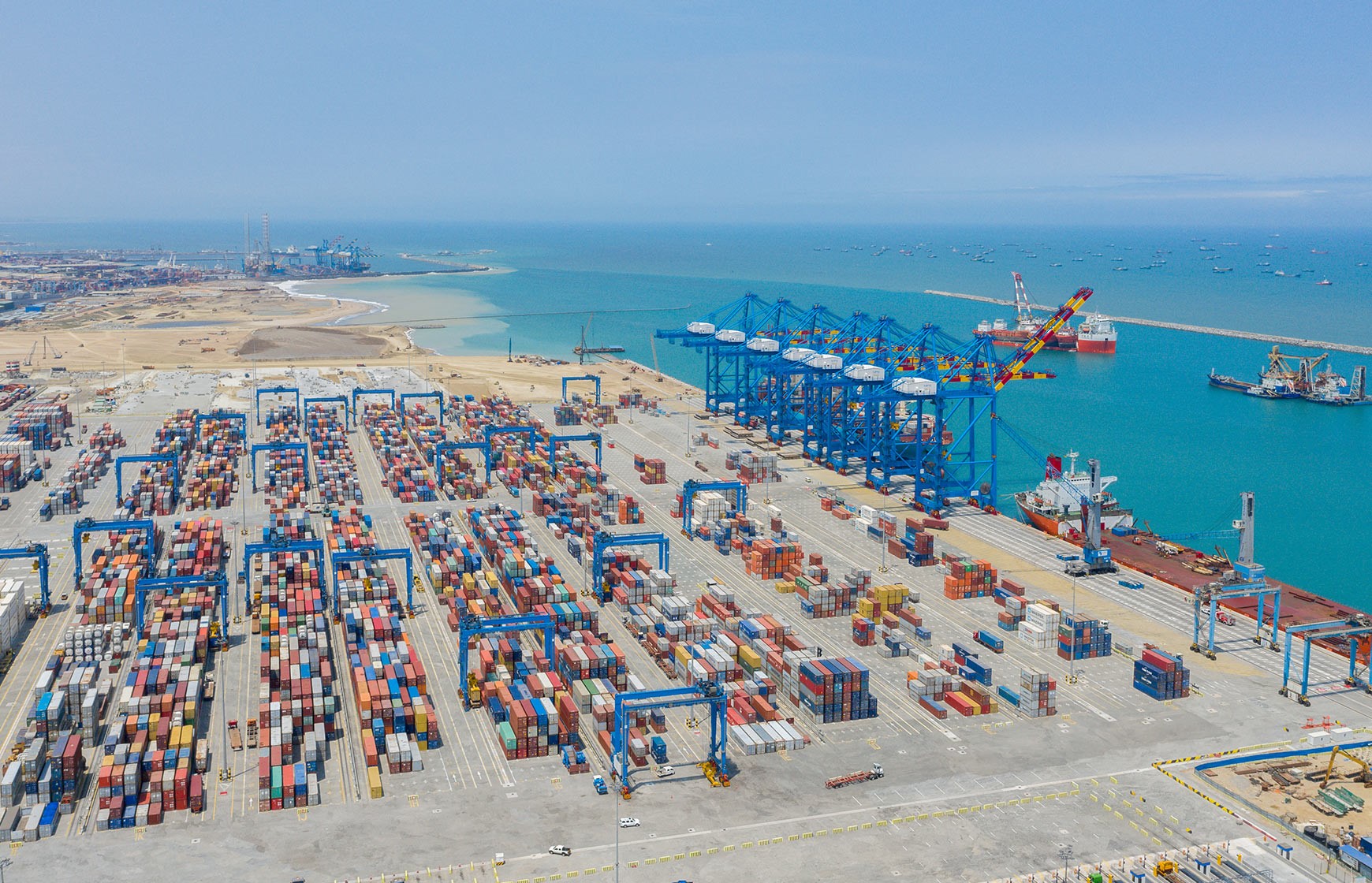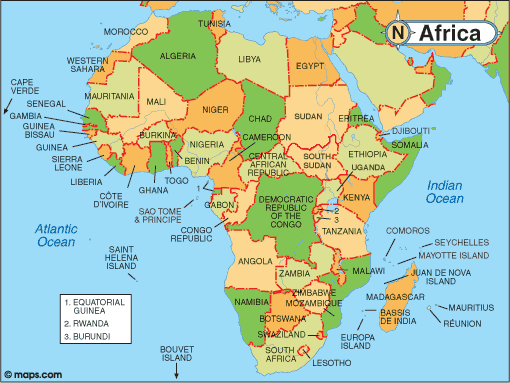Even though countries in Africa are endowed with many natural resources, most of them are poor and are beset by numerous problems. They have not been able to find ways to transform their huge potentials into reality. Since the attainment of independence from the late 1950s to the present time they have adopted and attempted various economic policies geared toward attaining growth in their economies and improving the standard of living of their people.
However more than 60 years later, all these countries are faced with huge balance of payment deficits, massive foreign debt burdens, and social as well as political problems that together seem to make the prospects of development more elusive than ever. The numerous models that have been tried by the individual countries on the continent in their attempt to remove themselves from the horns of economic, political and social difficulties on which they seem to be impaled have not yielded the desired results and the search for that elusive method for development continues.
One such model, which has and is still being tried, is regional economic integration (The interesting thing is that the reasons given for our underdevelopment have not changed much for the past 50 to 60 years and neither have the proposed solutions).
The latest scheme that has been formed is the African Continental Free Trade Area. Given the many integration schemes on the continent, it is useful to examine why despite the less than expected results at the regional levels, integration at the continental is being proposed as a means to achieving or accelerating development in the partner countries when schemes such as ECOWAS has since its formation in 1975 has contributed so little to development in the region. Why should we expect anything different from a continental integration scheme which is the regional schemes writ large?
Perhaps the African Continental Free Trade Area will do things differently and will not be captured by international development agencies for the implementation of their policies nor muddle around as political institutions rather than following a clearly defined path for the restructuring of the economies of their members. The reasons given for the formation of such schemes now sound like a broken record. It is as if by simply stating the virtues of economic integration, will bring them to fruition.

Economic integration is an expensive venture. It costs resources that could be used for other things in the member countries. 0.5% is levied on all imports to Ghana as ECOWAS levy. Should the ECOWAS levy be on global imports? Shouldn’t it be on a percentage of import duties that would have been paid if there had not been regional free trade? What are the benefits that Ghana gets in return? It would be useful to undertake an evaluation of regional integration schemes to see whether they are achieving their objectives. This will be for two reasons; whether members are getting value for money and whether they can play the role being given to them as the building blocks for the continental scheme. The institutions of the various communities have become so self-encapsulated that they have become an end in themselves and unaccountable for their failure to deliver. A new approach to integration is required.
In this article and the ones that follow, I will look at whether the reasons given for integration as a tool for development are valid. The follow-on question will be that if they are valid, why is it that the regional integration schemes have failed to achieve their objectives after more than 40 years in existence. Is it to do with the institutional framework (the Treaties, institutional structures, the organizational structure, the method of hiring personnel, etc.), the process mechanisms or the theoretical framework?
In this specific article we will look at the disadvantaged position of developing countries in international trade and the belief that integration schemes will enable them to overcome such disadvantage. But before that we want to look at the objectives of the continental scheme and at the theoretical framework of economic integration as a context.
Reasons for setting up a Regional Integration Scheme
The rational for regional economic integration schemes among African countries is, primarily, economic development. When one examines the objectives of the newly formed continental scheme, the same seems to be the case. The general objectives of the African Continental Free Trade Area, as stated in Article 3 of the Agreement are to:
(a) create a single market for goods, services, facilitated by movement of persons in order to deepen the economic integration of the African continent and in accordance with the Pan African Vision of “An integrated, prosperous and peaceful Africa” enshrined in Agenda 2063;
(b) create a liberalised market for goods and services through successive rounds of negotiations;
(c) contribute to the movement of capital and natural persons and facilitate investments building on the initiatives and developments in the State Parties and RECs;
(d) lay the foundation for the establishment of a Continental Customs Union at a later stage;
(e) promote and attain sustainable and inclusive socio-economic development, gender equality and structural transformation of the State Parties;
(f) enhance the competitiveness of the economies of State Parties within the continent and the global market;
(g) promote industrial development through diversification and regional value chain development, agricultural development, and food security; and
(h) resolve the challenges of multiple and overlapping memberships and expedite the regional and continental integration processes.

From the above General Objectives, members see the scheme as helping them to “promote and attain sustainable and inclusive socio-economic development, gender equality, and structural transformation”.[1] The General Objectives also expect the creation of a single market in goods and services facilitated by free movement of persons leading to the creation of a continental customs union. Furthermore, the scheme is expected to increase competitiveness of goods and services produced in the member states within the continent and in global trade. Industrialization, diversification, and enhancement of value chain development as well as agricultural development and food security are all aspects of development that the AfCFTA seeks to achieve.
Clearly, leaders on the continent believe economic integration is relevant for development. Even though, on the face of it, the continental free area is mainly for development purposes, there are political undercurrents that will decide whether it will be a success or not. Examples of how integration schemes have fared suggest that political considerations form the crucible in which the process is catalyzed. Before we examine issues that may facilitate or twat the progress of this new initiative, it might be useful to look at what economic integration is about, what the process mechanisms are, what the theoretical conditions that may facilitate the process are, and what the political and social implications are for the members.
Economic Framework of Integration
Economic integration has been defined as a process and a state of affairs. Regarded as a process, it encompasses various measures abolishing discrimination between economic units belonging to different national states. Viewed as a state of affairs, it can be represented by the absence of various forms of discrimination between national economies.’ There are various degrees of economic integration and depending on the extent to which the partners are willing to work with each other, it can vary from a free trade area to total integration with supranational institutions.
Economic integration schemes are usually categorized into five levels or stages. The first of these is the Free Trade Area. Within a free trade area, members agree to remove tariffs against the products from each other’s countries. However, each member remains independent in setting the tariff level on goods imported from non-member countries (third parties).

The second stage is the custom union. The main features of this stage are; the elimination of tariffs of the imports from member countries and the adoption of a common external tariff on the imports from the rest of the world (non-member countries), together with the apportionment of custom revenue according to an agreed formula. There are two main differences between a free trade area and a custom union. The first of these is that whereas members of the former retain independence in fixing external tariffs, members of a custom union adopt a common one. Secondly, a free trade area is equipped with rules of origin designed to confine intra-union free trade to products originating mainly within the area. The rules of origin are meant to operate against trade deflection which might result from the redirection of imports through the country with the lowest tariff to partner countries to exploit the tariff differential.
The third stage of economic integration is the common market. In addition to the characteristics of the custom union, a common market allows for the free movement of the factors of production. Economic union comes next with all the preceding attributes together with the unification of monetary, fiscal, and other policies.
The final stage of the process is total economic integration and is achieved when a supranational institution is formed which takes binding decisions on behalf of members.
Theory expects these stages to be linear with the scheme moving from a relatively low level to higher levels as the process intensifies. The process mechanisms that propel things forward have economic, political, and social implications for the member states. No integration scheme has followed this lineal path on the continent nor anywhere else. Instead, policies have been adopted that eclectically pick components from various stages of integration for implementation. What sometimes results is that such cherry picking creates a muddled approach and affects progress of the scheme to the extent that conditions that the lower levels of integration ought to create for the higher levels to use as building blocks do not exist thus creating problems for the process mechanisms.
Even though we have concluded from the General Objectives of the AfCFTA that the scheme is to facilitate development, it will be useful to question the reasoning behind the conclusion that the continental scheme will lead to development.
Examining the reasons for embarking on integration
Why do African countries and those who advocate regional integration feel it is an imperative for development? Is the reasoning behind the formation of such schemes valid? If they are valid then the obvious question will be why the existing schemes on the continent have failed in achieving their main objectives. Failure will then have to be attributed to the background conditions and the process mechanisms. ECOWAS, SADC, COMESA, EAC are all examples of schemes that have failed to achieve their substantive objectives. Could it be a confirmation by those who say that developing countries do not have the background conditions for forming regional integration schemes? The failure of integration schemes among developing countries to achieve their main objectives is not limited to Africa alone. The formation of a new continental scheme must be looked at in the context of whether or not existing scheme have added value to their members’ development or whether it will join an already existing list of failures of integration among developing countries. Also, if on the other hand, the reasons are not valid then we will have to conclude that regional economic integration may be a necessary or sufficient condition for industrial development of African countries.
Industrialisation as a reason for integration
Since the second world war, industrialization, especially manufacturing has experienced faster growth than any other sector of economic activity. It has also increased its share and value of internationally traded goods, and the inability of developing countries, especially those in Africa, to share in the gains from such growth, has been cited as a major factor accounting for their slow growth.
This assertion presupposes that resources that were earned through other means were invested optimally by African countries and therefore that they would have developed even faster if they had shared in the growth that occurred in industry. It also presupposes that the level of primary exports was maintained and export earning capabilities maximized. Unless it was the case that primary export levels were maintained, and earnings utilized properly, the connections between primary goods exportation and low economic performance are spurious.
However, regardless of the validity or otherwise of such presuppositions, industrialization is seen as a means by which the growth potential of West African countries can be realized, and integration is seen as the path to doing so.
The argument used by developing countries to justify the need for integration schemes and hence industrialization. This position is itself found in the arguments about the asymmetrical distribution of the gains of international trade in favour of manufactured goods relative to primary goods.
The importance of this issue to the development debate and integration as a tool makes a thorough examination of the arguments necessary because they underpin the validity of embarking on integration as a strategy for industrialization.
Is the exporting of primary goods responsible for low development?
The four main issues seen as affecting the export earning capacity of primary goods are; deterioration terms of trade, unstable prices, agricultural protectionism in developed countries, and the over dependence on a narrow range of commodities.
It used to be believed that diminishing returns in agriculture and mining would lead to a tendency for prices of these commodities to rise relative to those of manufactured goods; and because of that for there to an equalization of factor prices. However, research has shown the reverse to be the case. Movement of prices seem to show a declining terms of trade for exporters primary producers.
From this conclusions on the secular trend of the relative terms-of trade of primaries and manufactured goods, to what extent can the slow growth and lack of economic development in Africa be attributed to declining prices of primaries, and how do these support the calls for industrialization which integration is expected to facilitate?
Export of primary goods and economic growth
Even though research suggests that African countries and developing countries in general, on average, are disadvantaged in international trade, such figures alone are not sufficient for conclusions of the sort the question above asks. To arrive at a conclusion that shows a positive correlation between deteriorating terms of trade and slow growth, one will have to prove that the countries involved would have fared better if they had not been participating in international trade ( the counter factual cannot be established so this argument will ignored). It would also be necessary to demonstrate the ways in which the declining trend has affected their development goals. Some of these goals include economic ones such as: growth in per capita income or product; domestic distribution of income, and wealth; and economic power; utilization of production capacity and cyclical stability in real output; price or nominal stability; and international economic position. Furthermore, whilst aggregate price trends may indicate a trend, different commodity groups and commodities within such groups differ in their performance over the long term.
When commodities are desegregated, they show different price movements and differences in volatility which justify the need for caution in drawing broad based inferences from overall figures. Apart from the differences that may exist between different commodities, another point worth noting is the effect of price movements on different regions within the developing world. This point is relevant because of the tendency to sometimes lump countries together under the label of “developing” and then proceed to generalize based on this categorization. Studies show that whereas non-oil export commodity prices remained important in the net barter terms of trade for Southeast Asia and Africa, it does not for Latin America. Additionally, while the relative importance of non-oil commodity prices increased for Africa over the period when the studies were made, they seem to have declined in importance for Southeast Asia because of the increasing importance of manufactures in their exports.
At the country level, the BRIC and NIC countries have a negative relationship between nonfuel commodity prices and net barter terms of trade because of the importance of manufactures in their exports. They therefore experience improvement in their net barter terms of trade when prices of primaries are falling.
Since developing countries export different mixes of primary products with differing price trends and fluctuation rates, and the net barter terms of trade of primaries is of more significance to some than others, generalizations cannot be made to cover them all. Moreover, because developing countries are net exporters of raw materials for tropical beverages and net importers of other foods, the net effect of price trends of cereals, for example, on the purchasing power of their exports must also be considered.
Conclusions as to whether trends in the net barter terms of trade have affected the growth potential of any particular country or group of countries must also show whether there is an aggregate relationship between net barter terms of trade and lower purchasing power if quantity increases fail to compensate for the fall in prices.
Even though the following statistics is bit dated, it nevertheless illustrates the point being made. A study of some countries in West Africa showed that they were able to maintain their export earnings over the periods studied. Between 1974 to 1979 Burkina Faso, for example, experienced an average 2% rise in its terms-of-trade and a 59% increase in the quantity of exports. Her merchandise trade increased from 18 million dollars in 1965 to 161 million dollars in 1980 and to 198 million dollars in 1987.
Increase in export quantities more than compensated for deteriorating terms-of-trade between 1980 and 1985. The low growth rate of 2.5% over the 1973 to 1987 cannot therefore be attributed to lower export earnings. A corollary to the fact that price trends differ for different commodities is the fact that price changes are inevitable in a market situation as a response to supply and demand conditions. Thus, for any product, falling prices may only be a reaction to supply and demand conditions. It is only when price trends follow a declining path over time and supply and demand elasticities are such as to make increases in supply unable to compensate for falling prices that conclusions can be made for unprofitability in that particular commodity.
Evidence shows that between 1900-13 the purchasing power of all primary commodities in terms of manufactures increased at a rate of 4.5 percent a year. This fell to 0.4 percent between 1921-38. From 1955 to 1983 growth was 4.2 percent a year. The purchasing power of nonfuel prices also increased at 2.8 percent a year between 1955 and 1983 even though terms of trade declined at 0.4 percent a year. This negative trend was compensated for by a 3.2 percent increase in export volumes.
In view of the increase in the overall purchasing power of commodity exports, and the income terms of trade of nonfuel exporting developing countries, one cannot conclude that trade per se or trade in nonfuel commodities has been harmful to countries specializing in their production. Any conclusions that one draws must be country and commodity specific. Growth must also take account of factors such as government pricing and investment policies and their effect on output in the export sector, autonomous factor supply growth, and market structures.
A positive correlation between declining net barter terms of trade and growth cannot therefore be assumed a priori because there are large differences in the net barter terms-of-trade of developing countries and between commodities. It is difficult to make useful generalizations between world primary products and world manufactured products. The only valid generalization that can be made is that trends tend to be against underdeveloped countries and in favour of developed countries.
Though it has been suggested above that deteriorating terms of trade alone cannot explain the poor economic growth of developing countries in Africa, the political strength such arguments hold are very significant. African countries have on average experienced deteriorating terms of trade. Even if increased export quantities compensated for the fall in prices relative to manufactures, the point remains that they are disadvantaged. More significant to African countries, is that terms of trade have deteriorated for most of them since independence. The politically significant years have been from the 1960s which have been shown by various studies to have been a period of deteriorating terms of trade for nonfuel exports especially.
Another generalization that can be made is that if such a general decline in the terms of trade of primaries continues, then the import capabilities of the countries exporting such commodities concerned will be impaired. For such countries, especially those specializing in a narrow range of primaries the solution might be to diversify. However, diversification does not necessarily result in a steady or increasing trend in the terms of trade. If it results in a widening of the range of primary exports, the effect might be an overall steadying of export earnings if the new products do not experience declining trends themselves. In this case the new products will be compensatory in their effect. On the other hand, if the new products have declining or stable trends then they will either aggravate the situation or leave it unchanged.
We can conclude, from the above arguments, that volatility in the export earnings of developing countries does not necessarily derive from economic factors, although it might. Neither does poor economic performance derive from deteriorating terms of trade alone. Secondly, diversification will not necessarily alleviate the problem through less concentration on a single product, although it might because the new product might be an unstable crop and therefore additive in its effect or compensatory if it is not unstable.
The experience of independent Africa has been one of fluctuating earnings from export of primary products. It is, however, important to ascertain whether the instability in the export earnings of a country seeking to become integrated with other countries is really a result of economic forces or whether political forces are the real reason. If one of the reasons for integration is to increase the bargaining position of member countries in international trade, such a country is unlikely to benefit from concerted bargaining efforts of the integrated bloc more than it was doing individually within the universal trading system.

This is because even if more stable prices were negotiated, domestic policies may hinder the ability to take advantage of the new opportunities. However, for those countries that face unstable market conditions, economic integration may be a way of regulating the market if a large proportion of producers of the commodity are within the integrating area. Even then, since price stabilization involves substantial capital, the ability of the participating countries to regulate the market may prove to be very difficult and expensive and may indeed be beyond their financial capabilities.[i]
Apart from diversification, and price stabilization methods being used as a way of overcoming the difficulties and uncertainties posed by exporting primaries, many in the developing countries feel that the best way to move forward is through industrialization. This has the advantage of long-term restructuring of their economies and therefore tackles the fundamental problem of dependence on primary exports. A policy of industrialization ought not imply an entire shift from agricultural production to industrial production. It need not be a zero-sum game. The two sectors ought to co-exist.
The exportation of primaries might stimulate development through the exporting of goods produced with otherwise unexploited and unutilized human and natural resources if there is a large and expanding foreign demand. However, the overdependence on outside markets and the inability of primary producers to respond to changing demand conditions places severe restrictions on their foreign exchange earning capacities. Because the ability to re-allocate national resources in response to international exchange opportunities and to new technological possibilities is necessary for competitive advantage, this would imply that developing countries, including those in Africa cannot fully exploit the advantages of international trade. This is because of the rigid supply and demand conditions they face. Expanding, reducing, or changing from the production of one good to another is therefore very difficult.
The flexibility needed and brought about by the ability to respond to market signals by combining factors in different proportions according to price signals and profit incentives can only be achieved by removing the excessive rigidity in the economic structure of the developing economies. Because the industrialized countries seem to be able to respond more quickly and to take advantage of opportunities more easily, developing countries feel that by emulating the developed countries they will be able to escape from instability and future uncertainties. Additionally, even though as was noted earlier, developing countries have since the second world war experienced increased absolute earnings in their foreign transactions, it is also agreed that their earnings together with other sources of foreign exchange, such as aid, direct foreign investment, loans and grants will not be sufficient to meet, both, their growing needs and development aspirations.
Experience with policies to industrialize
Industrialisation has always been a policy advocated by those who subscribe to the conclusions of the deteriorating terms of trade argument. It was also an argument which was both overtly and tacitly accepted by African political leaders and referred to in their speeches. Import substitution industrialization was therefore embarked upon by quite a few countries of Africa after independence.
Even though African countries, such as, Ghana embarked upon import substitution industrialization in the early 1960s, the policy failed for several reasons. Among the well-known factors were the heavy dependence on foreign inputs and the lack of linkages with the domestic economy. The high dependence on suppliers credit, neglect of the traditional foreign exchange credit, neglect of the traditional foreign exchange earning sector as a result of the divergence of funds to industry, high infrastructural investment requirement and the installation of output capacity that were far in excess of what the domestic market could support, lack of the entrepreneurial, management and labour skills, shortage of raw material inputs, together with a lack of coordination led to an industrialization programme, laced with a heavy dose of modernization which proved wasteful, unsuccessful and positively detrimental to the balance of payment position of the country.
Even though not all African countries embarked upon industrialization and modernization with the same vigour as Ghana did, there is no doubt that many would have faced similar problems, partly as a result of the inherent problems of the import substitution paradigm itself and because of other problems internal to the countries themselves. The failed case of Latin American import substitution industrialization attest to this.
Structural change in developing countries, therefore, has its problems. As the experience of import substitution industrialization has shown, the diversion of funds from other sources and uses to the new industrial sector results in a neglect of those sectors and to huge balance of payment deficits. The “quasi-capital” character of the neglected sectors was usually not considered, so that eventual deterioration in its foreign exchange earning capacity resulted in the heightened inability to sustain the industrialization programme.
From the above we can conclude that despite what is seen as the unfavourable distribution of the gains of trade for primary producers, trade with developed countries is strategically important to developing countries because it enables them, among other things, to import goods that they cannot produce themselves, but are necessary for the maintenance and expansion of production. However the combination of demand and supply conditions, coupled with agricultural protectionism, discovery of synthetic substitutes, decrease in raw material input requirements per unit of output as a result of increasing technological development, together with increased agricultural productivity in the developed countries mean that the developing countries cannot expand their exports to the level that will help maintain their present import needs and finance new industrial programmes.
Moreover, the graduated nature of tariffs in the developed countries means that even if the developing countries tried to improve the market conditions of their products by exporting processed goods, they will meet formidable barriers which will make them uncompetitive. Most African countries have preferential access to the EU market through the Cotonou Agreement or bilateral relationships and under the General System of Preferences for non-traditional industrial exports. The real constraint they face in exporting manufactured goods is that their goods suffer from shortcomings such as quality, design, degree of standardization, and compliance with contracted delivery dates. Such shortcomings make it difficult for them to be able to compete effectively for consumer choice in the markets of the developed countries.
Since a minimum import of inputs is needed for the realization of growth potentials, and since there would appear to be a virtual ceiling on their exports, developing countries experience a foreign exchange gap as a result of the excess demand of imports over exports.
To overcome the dilemma posed by the constraint of foreign exchange, it is suggested that industrialization would be more feasible if it is done on a regional basis within the context of a custom union. This, it is hoped will create a regional market of sufficient size to make the setting up of industries possible without the need to rely on the markets of the developed countries. It is, also, expected to help in the realization of economies of scale, and make it possible for the countries to conserve foreign exchange through the imposing of prohibitive tariffs on “luxury” goods. From these perspectives it is felt that industrialization would be more sustainable and viable within the context of regional integration.
Regional integration among developing countries seek to avoid creating enlarged markets for multinational corporations. This is because local industries are unable to compete with the might of such companies. The growth of local industry will therefore be hampered by unfair competition from foreign investment. The desire to reduce dependence on foreign direct capital will not be fulfilled. This is one of the reasons why ECOWAS, for example, has elaborate guidelines about rules of origin. This is to prevent the re-exportation of imported goods and, as previously explained, to ensure that local participation is adequate before goods are eligible for preferential treatment.
Conclusion
Our conclusion is that though there may be a secular deterioration in the terms of trade for exporters of primary goods, the impact of that on the growth of an economies of developing countries cannot be generalized. A desegregation of goods and price movements of the net barter terms of trade as well as the income terms of trade must be considered when drawing conclusions about the impact of primary commodity exports and development. The argument for industrialization as a means of overcoming the disadvantage of being primary producers may be valid but is not a sufficient argument for integration among a broad group of countries because of differences in the impact of world prices on their income. Other reasons must support the efficacy of integration to be successful. The suggestion of variable geometry in the Agreement may be the answer to the differential impact of prices movements in world trade for members of the continental free trade area. This must be juxtaposed with the single undertaking clause in the Agreement.
Industrialisation may be a necessary condition for growth for some but not all members of the continental scheme and it is not a sufficient reason on its own for economic integration.
[1] Article 3 (e), Agreement Establishing the African Continental Free Trade Area.










